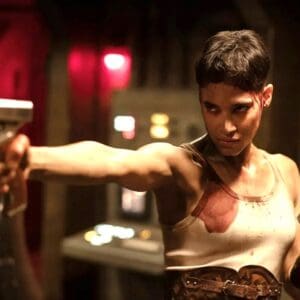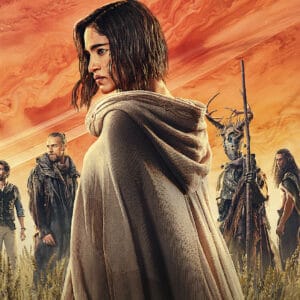Last Updated on August 12, 2024

Plot: Delve further into the mythology and madness of Zack Snyder’s epic sci-fi saga in the viciously sexier, bloodier world of Rebel Moon — Chapter One: Chalice of Blood and Rebel Moon – Chapter Two: Curse of Forgiveness. In Snyder’s director’s cut, a peaceful settlement on a moon in the furthest reaches of the universe finds itself threatened by the armies of the tyrannical Regent Balisarius, and Kora, a mysterious stranger living among the villagers, becomes their best hope for survival. Tasked with finding trained fighters who will unite with her in making an impossible stand against the Motherworld, Kora assembles a small band of warriors — outsiders, insurgents, peasants, and orphans of war who share a common need for redemption and revenge. As the shadow of an entire Realm bears down on the unlikeliest of moons, a new army of heroes is formed.
Review: Like Michael Bay before him, Zack Snyder does not follow the credo of “less is more.” Almost every movie Snyder has made boasted a director’s cut billed as the definitive vision of the story he aimed to tell. While extended cuts can often restore sequences and subplots that detracted from the theatrical version’s flow, fewer have improved a movie or been more than a cinematic curiosity. After the campaign to get Zack Snyder’s original vision for Justice League was successful, the filmmaker’s next project was Rebel Moon. A gritty space opera in the vein of Star Wars, Rebel Moon was already two movies when it was revealed that extended versions would come our way before the year was out. While our own Chris Bumbray liked Part One: A Child of Fire more than Part Two: The Scargiver, most critics were not nearly as kind. Now, four months after the second film’s premiere, Netflix has unveiled the R-rated director’s cuts of both films. Retitled and with more than two hours of added footage, Rebel Moon has transformed from a decent sci-fi epic into an overlong but still decent sci-fi epic, albeit one with a lot more viscera and nipples on display.
I watched both Rebel Moon director’s cuts for this review, now subtitled Chapter One: Chalice of Blood and Chapter Two: Curse of Forgiveness. Most of the new footage is in the first film, increasing the running time by seventy minutes to just under three and a half hours. Overall, the plot and narrative flow of both films remain the same, with the added footage comprised of a new twenty-minute opening sequence in the first film, a fully nude sex scene in each movie, the rearrangement of the village training and harvest sequence with one part moved to the first film, several expanded flashbacks, and of course buckets of blood. I went as far as watching the original and extended cuts side by side to determine where the main changes are and was a bit surprised about some of the odd decisions Zack Snyder made in what he included in each version. Surprisingly, the extended cut did not improve the film experience for me, proving why longer and more explicit does not always mean better. It also illustrates that between both versions of the two movies, some choices work better than others.
The core narrative remains the same: Kora (Sofia Boutella), a former soldier of the Imperium, is hiding out on the moon of Veldt as a farmer. When the sadistic Admiral Atticus Noble (Ed Skrein) comes to the village demanding their harvest and kills the town leader, Kora and Gunnar (Michiel Huisman) set out to recruit warriors to defend their land. In the extended cut of the first film, there is a new opening scene that flashes back to the recruitment of soldier Aris (Sky Yang), which ties into more sequences of the young man’s courtship of villager Sam (Charlotte Maggi). The scene boasts a gnarly head bashing that is shown explicitly, followed by a recurring motif involving an unexplained collage made of teeth. This dental MacGuffin recurs throughout the director’s cuts with no reference to its purpose outside of being sadistic and weird. Much of the new material feels that way, mostly comprised of the laser blast deaths in the theatrical cut, which now include poorly animated blood splatter that cascades across the slow-motion frame like a Jackson Pollock painting. There are also balletic explosions of skulls that occur no less than fifty-five times through the two movies. The first few were gnarly, but by the double-digit mark, they were boring and unoriginal. This cut is chock full of stabbings, throat slitting, and buckets of CGI blood, which eventually add up to the majority of the extended footage.

The film also does away with the majority of Anthony Hopkins’ narration despite additional scenes peppered throughout the film, showing Jimmy gathering his new adornments as he prepares for battle. The extended cuts are favorable to many supporting characters, including Titus (Djimon Honsou), Milius (Elise Duffy), Tarak (Staz Nair), and Nemesis (Doona Bae), all of whom get added footage to their backstory sequences in Chapter Two. Milius has added scenes where the original cut had her talking about it. The other additions to the Director’s Cuts are two extended sex scenes and some female nudity in the new opening of the first movie. Both sex scenes involve Sofia Boutella. One is hinted at in the original cut as we see Kora and Gunnar nude in bed after making love, but the other comes early in the first movie and feels very out of place. It is well shot despite having no purpose other than showing some skin.
The other substantial change between the films, as teased in the Director’s Cut trailer, is the living core of the dreadnought ships. We see the female visage, reminiscent of H.R. Giger in visual design, at the end of the second movie and a disconnected reference by the King (Cary Elwes) to the “Kali.” Still, the extended cuts reveal that these giant robot-like entities are living beings able to emote and speak. It is a cool yet still underbaked plot element that feels added in without much explanation. The same can be said for the expanded flashbacks, which boast a lot more gory bloodshed and add details to the path of Balisarius (Fra Fee) from soldier to despotic leader. Several years younger than Sofia Boutella, Fee never quite becomes the brooding shadow of a major villain that Zack Snyder wants to make him out to be. Still, the attempt is clearly meant to mimic Star Wars and Emperor Palpatine.
Snyder makes a couple of shifts in structure, mostly in Chapter Two. These involve moving the training of the villagers to after-the-harvest sequences rather than intercutting them. This makes them feel sequential but also puts a lot more focus on slow-motion shots of wheat being cut, bundled, and hauled back to the village. I stopped counting after fifteen minutes, but there is a lot of farming porn added to the film. Cumulatively, the biggest chunk of the two hours added to Rebel Moon is the opening of both films, the new closing scene of the second film, two sex scenes, and some flashback moments. These add up to roughly an hour, with the remaining sixty minutes and seconds trimmed from virtually every action sequence and death shot, now focused on showing blood flowing artistically across the screen. When comparing the two versions of each film, it is easy to see that the initially released versions leave more to the imagination. In contrast, the Director’s Cut forces us to drown in bright red pixelated plasma.
Director’s cuts are intended to serve as the true vision the filmmaker set out to make, but in the case of Rebel Moon, it feels as if the original versions were better than what Zack Snyder was aiming for. Very little of the new footage registers as an improvement over what we already saw, with the sex scenes and exploding heads merely gratuitous. Taken as two halves of a single story, the first part remains the stronger of the two chapters. The films still hinge on the charisma of Sofia Boutella and rooting for opposing sides in an outer space power struggle that feels more complicated than it needs to be. The additional backstory of the mechanical beings that power the massive dreadnoughts and a new closing scene set up more stories in the Rebel Moon universe. Still, it served more as tacked-on footage for a film that did not need more padding. The Rebel Moon director’s cut detracts from the integrity of the original cuts by making audiences slog through six hours of visuals with only four hours of story.





















Follow the JOBLO MOVIE NETWORK
Follow us on YOUTUBE
Follow ARROW IN THE HEAD
Follow AITH on YOUTUBE